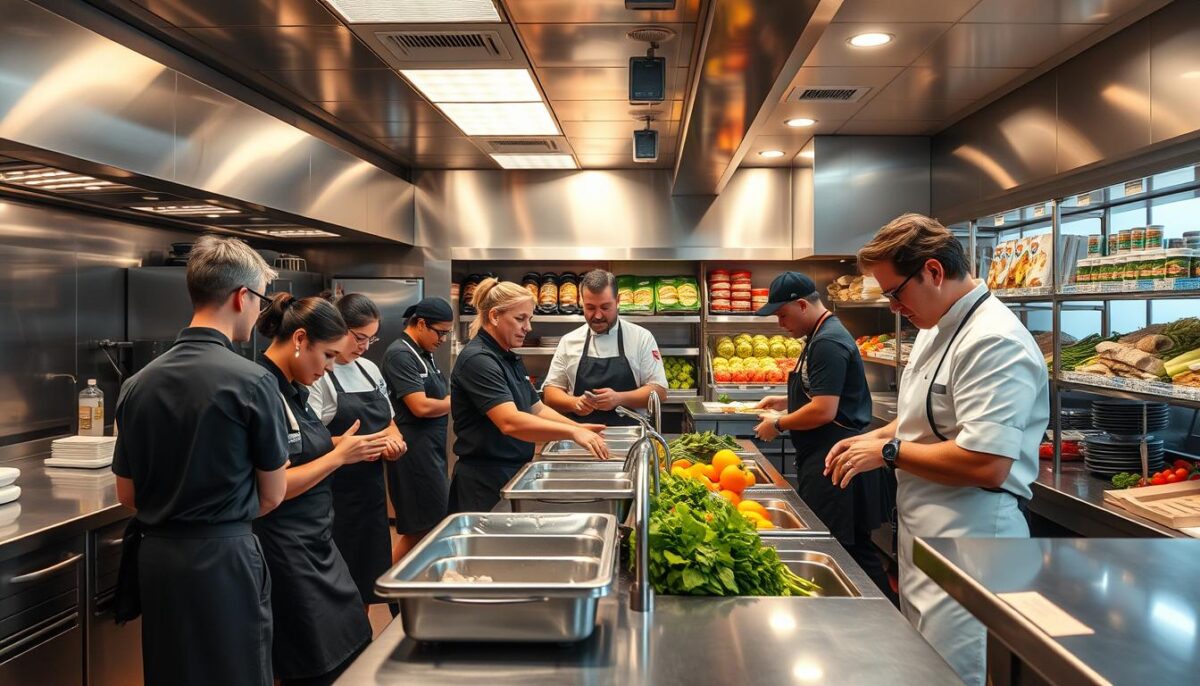
The Ultimate Guide to Restaurant Marketing: Creative Ideas That Work
July 15, 2025
4 Common Food Safety Mistakes That Trigger Health Code Violations
July 15, 2025As a seasoned professional in the restaurant industry, I’ve witnessed firsthand the devastating impact of foodborne illnesses on even the most successful establishments. The stark reality is that 600 million people worldwide fall ill after consuming contaminated food each year, resulting in 420,000 deaths annually.
This is not just a statistic; it’s a harsh reminder of the importance of maintaining stringent food safety protocols in your kitchen. A single incident can lead to reputational damage, financial losses, and potential legal consequences. So, what are the hidden risks that could be lurking in your restaurant’s kitchen?
Key Takeaways
- Understand the six most critical yet overlooked food safety risks in your restaurant.
- Learn practical steps to identify and mitigate these risks.
- Discover how to transform food safety into a competitive advantage.
- Protect your customers’ health and your restaurant’s reputation.
- Stay ahead in today’s hyper-connected world where a single incident can go viral.
The Invisible Threats to Your Restaurant’s Reputation
In the competitive world of restaurants, reputation is everything, yet there are hidden risks that could jeopardize it. As a restaurant owner, managing these risks is crucial to maintaining customer trust and ensuring the longevity of your business.
Why Food Safety Matters More Than Ever
Food safety is a critical aspect of running a restaurant, as it directly impacts customer health and your business’s reputation. With the rise of social media, a single food safety incident can quickly escalate into a public relations crisis, damaging your reputation and deterring potential customers.
Maintaining high food safety standards is not just about compliance; it’s about building trust with your customers and protecting your business from the financial and emotional toll of foodborne illness outbreaks.
The Real Cost of Food Safety Failures
The consequences of food safety failures can be devastating. Here are some key statistics that highlight the potential costs:
| Cost Category | Potential Cost |
|---|---|
| Direct Costs of Foodborne Illness Outbreak | Exceeding $75,000 |
| Permanent Closure Rate | Up to 60% |
| Staff Turnover Increase | Dramatic increase |
| Insurance Premium Increase | Double or triple |
These statistics underscore the importance of prioritizing food safety in your restaurant operations. By understanding the potential risks and taking proactive steps to mitigate them, you can protect your business and maintain a strong reputation.
Hidden Food Safety Risks Lurking in Your Kitchen
Kitchens can harbor hidden dangers that threaten food safety. While maintaining a clean and organized kitchen is crucial, there are several often-overlooked areas that can pose significant risks.
Cross-Contamination: The Silent Culprit
Cross-contamination is a significant risk in any kitchen. It occurs when harmful bacteria are transferred from one food to another, often through utensils, cutting boards, or improperly cleaned equipment. To mitigate this risk, it’s essential to implement proper cleaning and sanitizing practices and ensure that staff understand the importance of separating raw and ready-to-eat foods.

Time-Temperature Abuse: A Ticking Time Bomb
Time-temperature abuse happens when food is not stored or cooked at the correct temperature, allowing bacteria to multiply rapidly. This can lead to foodborne illnesses. Ensuring that food is cooked to the right temperature and stored properly is critical to preventing this type of abuse.
Poor Hygiene Practices: More Common Than You Think
Poor hygiene practices are a common issue in many kitchens. Hand hygiene is particularly crucial, as improper handwashing can spread harmful microorganisms. Ensuring that staff wash their hands correctly and frequently, and providing regular training on hygiene practices, can significantly reduce the risk of food safety incidents.
By addressing these hidden risks, kitchens can significantly improve their food safety standards and protect their customers from foodborne illnesses.
Allergen Management: A Life-or-Death Responsibility
Allergen management is not just a regulatory requirement, but a life-or-death responsibility. As a restaurant owner, it’s crucial to understand the risks associated with food allergens and take proactive steps to mitigate them.
The Rising Prevalence of Food Allergies
Food allergies are becoming increasingly common, making it essential for restaurants to be vigilant. Effective allergen management requires a comprehensive approach that includes staff training, dedicated equipment, and clear labeling. I’ve seen firsthand how digital solutions can significantly reduce the risk of miscommunication compared to traditional paper-based systems.
Legal Obligations for Allergen Information
Restaurants have a legal obligation to provide accurate allergen information to customers. This includes ensuring that allergen information is verified at multiple points, such as when taking orders, preparing food, and delivering it to customers. Implementing a robust allergen control system is not just about compliance; it’s about protecting customers’ lives.
Implementing an Effective Allergen Control System
To implement an effective allergen control system, restaurants should consider using digital technology to streamline processes and reduce errors. This includes creating visual cues like colored tickets or plates to identify allergen-free meals. By doing so, restaurants can ensure that staff are trained to handle allergens safely and that customers receive accurate information.
By prioritizing food safety management and safety management in the kitchen, restaurants can protect their customers and their reputation. Effective allergen management is a critical component of overall food safety, and it’s essential to get it right.
Expiration Date Monitoring: Beyond the Basics
Beyond simple date checking, expiration date monitoring involves a complex set of practices to ensure food safety in restaurants. It’s not just about checking dates; it’s about understanding the implications of those dates on the safety and quality of the food served.
Understanding “Use By” vs. “Best Before” Dates
The terms “Use By” and “Best Before” are often confused, but they have distinct meanings. “Use By” dates are related to food safety, indicating the last date recommended for the use of the product. “Best Before” dates, on the other hand, refer to the quality of the product. Understanding this difference is crucial for effective inventory management and storage practices.
The Dangers of Improper Date Monitoring
Improper date monitoring can lead to food being served past its safe consumption date, potentially causing food safety issues. This can result in customer dissatisfaction, legal issues, and damage to the restaurant’s reputation. Implementing a robust date monitoring system is essential to mitigate these risks.
Digital Solutions for Expiration Date Tracking
Digital solutions can significantly enhance expiration date tracking. Modern inventory management systems can integrate with temperature monitoring equipment to adjust expiration dates based on actual storage conditions. This not only improves compliance with food safety regulations but also reduces waste.
By adopting digital expiration date tracking systems, restaurants can reduce food waste, improve inventory control, and enhance overall food safety. As I’ve experienced, such systems can reduce waste by up to 34% while improving compliance.
Supply Chain Traceability: Knowing Your Food’s Journey
Ensuring the safety and quality of your food requires a deep understanding of your supply chain. Lowering the food miles of your products and auditing your suppliers are crucial steps in this process. The US FDA has emphasized the need for a more technologically advanced food safety system to track and trace food effectively from farm to fork.

Transparency Matters
Having a transparent supply chain is not just about avoiding problems; it’s about creating a story around your food that builds customer trust. By reducing the number of suppliers and developing deeper relationships with those that remain, you can enhance communication and accountability. This approach not only strengthens food safety practices but also differentiates your restaurant from competitors.
Common Gaps in Traceability
Many restaurants face challenges in maintaining a transparent supply chain due to gaps in traceability. Common issues include inadequate supplier audits and a lack of real-time tracking. To address these gaps, I recommend starting with high-risk ingredients like seafood, meat, and fresh produce. For more insights on choosing reliable suppliers, you can visit this resource on selecting fresh produce suppliers.
Building a Transparent Supply Chain
To build a more transparent supply chain, consider implementing technology solutions like blockchain for end-to-end traceability. This can be shared with customers through QR codes or digital menus, enhancing their dining experience. Regular supplier audits, where you personally verify their food safety practices, can also strengthen relationships and ensure compliance.
- Reduce the number of suppliers to enhance communication and accountability.
- Implement technology like blockchain for end-to-end traceability.
- Conduct regular supplier audits to verify food safety practices.
- Start with high-risk ingredients when improving supply chain transparency.
Creating a Food Safety Culture Among Your Staff
To ensure food safety, it’s essential to foster a culture among staff that prioritizes it. A robust food safety culture is not just about following rules; it’s about creating an environment where staff understand the importance of their role in maintaining safety.
Why Rules Alone Don’t Ensure Compliance
Simply having rules in place doesn’t guarantee compliance. Staff need to understand the reasoning behind these rules to adhere to them effectively. For instance, maintaining consistent temperature control is critical in preventing bacterial growth. I ensure that my staff comprehend the significance of temperature monitoring in keeping food safe for consumption.
Training Beyond Checklists: Building Understanding
Training programs should go beyond mere checklists. They should educate staff on the ‘why’ behind food safety practices. I implement comprehensive training that includes the importance of proper food storage, handling, and preparation techniques. This not only enhances their understanding but also empowers them to make informed decisions.
Empowering Staff to Take Ownership of Food Safety
Empowering staff means giving them the authority to take action when they identify a food safety issue. I achieve this by assigning specific food safety responsibilities to different team members, such as allergen management or sanitizer concentration checks. This creates a sense of ownership and accountability.
| Strategy | Benefits |
|---|---|
| Recognition Programs | Celebrates staff achievements in food safety, fostering a culture of pride. |
| Peer Audits | Encourages mutual accountability and shared learning among staff. |
| Assigned Responsibilities | Creates ownership and expertise in specific food safety areas. |
By implementing these strategies, I have seen a significant improvement in my restaurant’s food safety culture. Staff are more engaged, and our overall safety record has improved.

Conclusion: Protecting Your Restaurant Through Vigilance
As we wrap up our exploration of hidden food safety risks, it’s clear that vigilance is key to protecting your restaurant. Ensuring food safety and hygiene is not just about avoiding foodborne illnesses; it’s about maintaining a positive reputation and protecting your customers’ health.
I’ve shared the six hidden food safety risks because I’ve seen how they can devastate restaurants that thought they were doing everything right. The most successful restaurants integrate food safety into their identity and operations, rather than treating it as a separate compliance issue.
To start protecting your restaurant, I recommend conducting your own risk assessment. Identify the hidden risks that pose the greatest threat to your operation and address them proactively. By doing so, you’re not just protecting your restaurant; you’re building a stronger business with more consistent operations and greater customer trust.
Begin by focusing on one area for improvement, then systematically address each risk until food safety excellence becomes part of your restaurant’s DNA. The restaurants that thrive long-term are those that make food safety a non-negotiable priority.
FAQ
What are the most common causes of foodborne illnesses in restaurants?
The most common causes are cross-contamination, time-temperature abuse, and poor hygiene practices. Ensuring that staff follow proper food handling and preparation procedures can significantly reduce the risk of foodborne illnesses.
How can I ensure my staff is properly trained in food safety practices?
Providing regular training and education on food safety is crucial. This includes understanding the importance of temperature control, proper food storage, and hygiene practices. I also recommend conducting regular audits to ensure compliance.
What is the best way to manage allergens in my kitchen?
Implementing an effective allergen control system is key. This includes identifying common allergens, labeling them clearly, and ensuring that staff understand the risks associated with cross-contamination. I also recommend having a clear policy for handling allergen-related requests from customers.
How can I improve supply chain transparency and ensure the quality of my ingredients?
Building a more transparent supply chain involves working closely with suppliers, conducting regular audits, and implementing a traceability system. This helps to identify potential risks and ensures that ingredients are handled and stored properly.
What are the benefits of using digital solutions for expiration date tracking?
Digital solutions can help streamline the process of tracking expiration dates, reducing the risk of serving expired or spoiled products. This can also help to minimize waste and improve overall food quality.
How can I create a food safety culture among my staff?
Creating a food safety culture involves more than just enforcing rules and regulations. It requires providing ongoing training and education, empowering staff to take ownership of food safety, and leading by example. By fostering a culture of food safety, I can ensure that my staff is committed to maintaining the highest standards.



